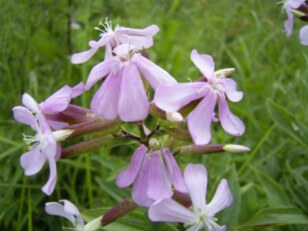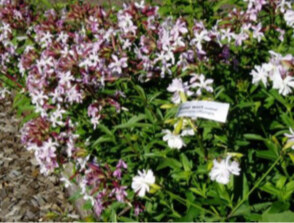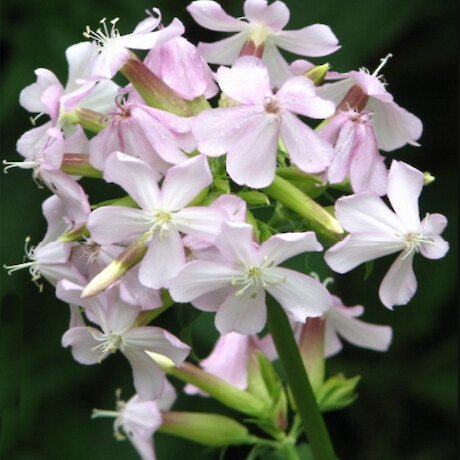Saponaria officinalis
Download info sheetSoapwort belongs to the Caryophyllaceae (Carnation) family originating from central and southern Europe. It grows well in temperate to cool climates, hardy - though requires good fertile soil and adequate summer watering to thrive.
“Bruised and agitated with water it raises a lather like soap, which washes greasy spots out of clothes.”
William Withering – ‘An Arrangement of British Plants’, 1796
Soapwort belongs to the Caryophyllaceae (Carnation) family originating from central and southern Europe. It grows well in temperate to cool climates, hardy - though requires good fertile soil and adequate summer watering to thrive.
“Bruised and agitated with water it raises a lather like soap, which washes greasy spots out of clothes.”
William Withering – ‘An Arrangement of British Plants’, 1796
 (Image: Saponaria officinalis flowers; TeunSpaans, https://commons.wikimedia.org/wiki/File:Saponaria-officinalis-flower.jpg#filelinks)Description: A stout herbaceous perennial with a stem growing to about 1 metre with a tendency to sprawl. Leaves lanceolate, slightly elliptical, acute, smooth, 2 or 3 inches long and 1/3 inch wide. Large pink flowers in paniculate fascicles, calyx cylindrical, slightly downy, five petals, unguiculate, top of petals linear, ten stamens, two styles, capsule oblong, one-celled, flowering from summer through to autumn.
(Image: Saponaria officinalis flowers; TeunSpaans, https://commons.wikimedia.org/wiki/File:Saponaria-officinalis-flower.jpg#filelinks)Description: A stout herbaceous perennial with a stem growing to about 1 metre with a tendency to sprawl. Leaves lanceolate, slightly elliptical, acute, smooth, 2 or 3 inches long and 1/3 inch wide. Large pink flowers in paniculate fascicles, calyx cylindrical, slightly downy, five petals, unguiculate, top of petals linear, ten stamens, two styles, capsule oblong, one-celled, flowering from summer through to autumn.
It has a slight aroma, with a bitter and slightly sweet taste, followed by a persistent pungency and a numbing sensation in the mouth - best not to eat it! If you rub the foliage you will create a soap like lather. When Soapwort root is dried, it is cylindrical, longitudinally wrinkled, outside light brown, inside whitish with a thick bark. This contains a number of small white crystals and a pale yellow wood. The double-flowered form is S. officinalis ‘Flore Pleno’
Parts Used: Fresh & dried root and aerial parts. The root is harvested in the spring and can be dried for later use.
NB: The HFNZ does not advise Soapwort to be used internally due to the irritating effects to the gastric mucosa by the saponin content. If used internally – use with caution and only with supervision of a Herbalist or other Health Professional.
Constituents: Saponins, saponin glycosides, resins, gum, fibre, mucilage.
Therapeutic Actions: The whole plant, but especially the root is alterative, antiscrophulatic, cholagogue, depurative, diaphoretic, mildly diuretic, expectorant, purgative, sternutatory (to help you sneeze, like snuff), cytotoxic and tonifying.
When used internally, Soapwort’s main medicinal use is as an expectorant. It has a strongly irritant action within the gut and this is thought to stimulate the cough reflex and increase the production of a more fluid mucus within the respiratory passages. This action makes it suited to treat bronchitis, coughs and asthma. The counter irritant effect can be used to halt asthma attacks. The Dutch physician, Boerhaave (1668-1738), recommended Soapwort for the treatment of jaundice. It was used also for the treatment of ‘visceral obstructions’ (lumps & tumours in the organs of the torso that should not be there) but is rarely used internally in modern herbalism due to its irritant effect on the digestive system. When taken in excess it destroys red blood cells and causes paralysis of the vasomotor centre. Also one of the saponins found in Soapwort is proving of interest in the treatment of cancer, it is cytotoxic to the Walker Carcinoma in vitro. This has piqued interest for other medicinal uses due to the ‘cytotoxic’ actions. A decoction of the roots or an infusion of the aerial parts can be applied externally to treat itchy skin and as a soothing wash for eczema.
Soap can be obtained by placing either the roots, leaves or the whole plant in cold water. Bring to the boil, then strain the liquid. When tepid, wash garments by swishing them in the liquid. It doesn’t lather a lot, but it does clean.

It is a gentle effective cleaner, used especially on delicate fabrics that can be harmed by modern synthetic soaps. It has both cleaning and brightening effects on delicate fabric. This process was used in the past by textile industries for a process called ‘fulling’, cleaning and thickening of newly woven fabric, hence one of its folk names Fuller’s herb.
Soapwort solutions are still used by museums and art galleries to clean precious works of art, particularly fabrics even today. A soapwort solution has been used to clean the Bayeux tapestry.
The roots can also be dried and stored for later use. Soapwort has been traditionally used as hair shampoo, though it can cause eye irritations (same as our store brought shampoos today).
Folk Names: Soapwort, Soaproot, Ladies wash bowl, Bouncing bet, Sweet betty, Old maids pink, Wild sweet William, Latherwort, Fuller’s herb, Bruisewort, Crow soap.
History & Mystery: “A decoction of Soapwort was used to cure ‘the itch’, and proved very useful in jaundice and other visceral obstructions. For old venereal complaints it was considered a good cure particularly when mercury treatments failed (referring to syphilis). It was used as a tonic, diaphoretic and alterative and considered to be a valuable remedy for rheumatism or cutaneous troubles resulting from any form of syphilis.
 Traditional dose from those times: “Decoction, 2 to 4 fluid ounces three or four times daily. Extract or the inspissated juice (To undergo thickening as by boiling or evaporation, condense, i.e. making a strong decoction) will be found equally efficacious: dose, 10 to 20 grains. As a sternutatory, 2 to 6 grains. Fluid extract, 1⁄4 to 1 drachm.
Traditional dose from those times: “Decoction, 2 to 4 fluid ounces three or four times daily. Extract or the inspissated juice (To undergo thickening as by boiling or evaporation, condense, i.e. making a strong decoction) will be found equally efficacious: dose, 10 to 20 grains. As a sternutatory, 2 to 6 grains. Fluid extract, 1⁄4 to 1 drachm.
It is also a sternutatory” (to help you sneeze), so could be included in ‘snuff’.
In North America it was grown as an ornamental, but has become a garden escapee. In some states it is declared a noxious weed. In earlier times it was used by both Indians and European settlers for a range of ailments and as a soap substitute.
Soapwort Shampoo:
30g dried soapwort root, 350mls filtered or distilled water, 1/2tsp (4g) rock salt, 4 tsp (20g) castor oil, 4 drops lavender essential oil.
Simmer finely chopped root in water for 20 minutes in a stainless or enamel pan. Cool, strain & filter into a clean bottle, add salt, castor & lavender oils. Apply a lid & shake well.
Before using shake well - use as you would a normal shampoo, and apply to a wet scalp.
This will only keep about a week in the fridge, to last longer add 50mls of vodka or brandy to preserve. Alternative, freeze in ice-block trays & thaw enough for use as required.
Prepared for the Herb Federation of New Zealand’s Herb Awareness Month 2022 www.herbs.org.nz
Advisory Note: This text is given as a general guidance. If any adverse reactions occur or symptoms persist, please contact a qualified medical herbalist or medical doctor immediately.

